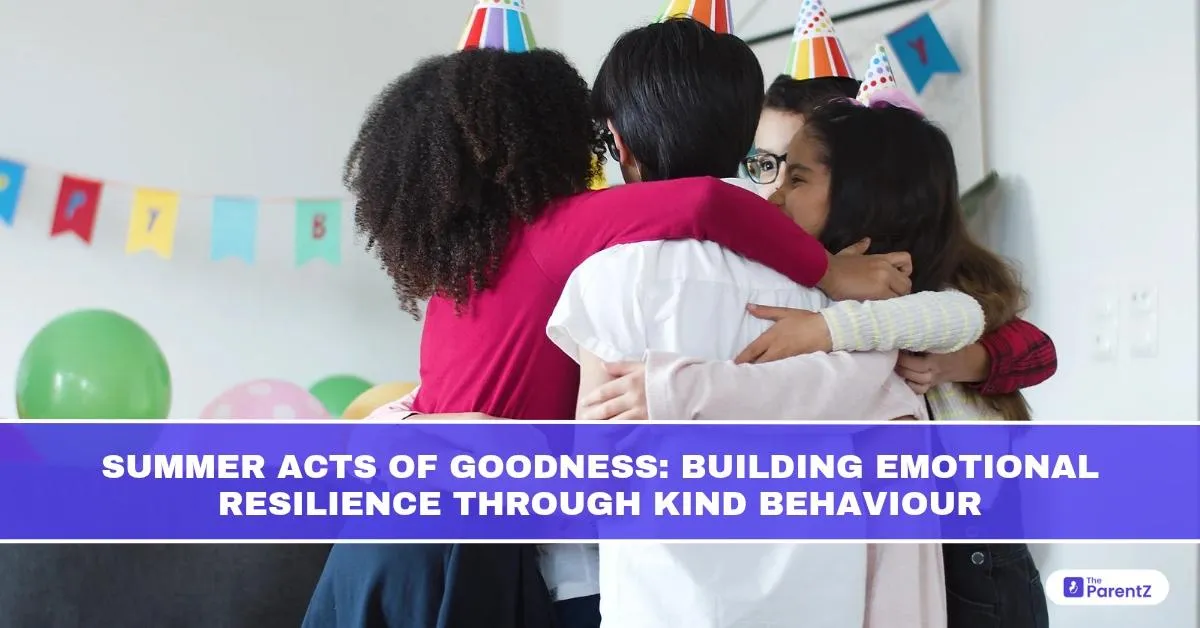“No act of kindness, no matter how small, is ever wasted.” – Aesop
Summer is often seen as a time for rest, play, and sunshine. But beyond vacations and ice cream outings, it offers something even more powerful: a chance to grow emotionally. When school pressures reduce and routines are more relaxed, children have the space to experience the world more openly. This makes summer the perfect season to practice goodness and kindness and unknowingly build lifelong emotional strength.
Kindness isn’t just a social virtue. It’s a protective factor in mental health. In fact, medical and psychological studies confirm that regular acts of kindness, even very small ones, can rebuild emotional resilience, reduce stress, and support brain health in children. And when done in a safe, nurturing environment like the home or community, these acts create a “positive loop” that boosts mood and emotional flexibility.
What is Emotional Resilience in Children?
Emotional resilience refers to a child’s ability to bounce back from stress, disappointment, or failure. It doesn’t mean not feeling sad or upset, it means being able to manage those feelings and keep moving forward.
Resilient children:
- Handle change and transitions better
- Show more patience and problem-solving ability
- Are less likely to feel overwhelmed by social pressure or negative emotions
While resilience is influenced by genetics and environment, one key contributor is social connection and kindness. When children experience themselves as capable of making others feel better, they develop a sense of worth, control, and purpose. This feeling is central to emotional stability.
How Kindness Builds Resilience: A Medical Perspective
Kindness triggers a biochemical chain reaction in the brain and body. Here’s what happens:
- Oxytocin release: Often called the “love hormone,” oxytocin promotes emotional bonding and reduces anxiety. It’s released when a child does something kind or experiences kindness.
- Serotonin and dopamine boost: These neurotransmitters are linked to happiness and motivation. Even a small act like helping a sibling or feeding a stray can give a child a sense of joy and achievement.
- Reduced cortisol (stress hormone): Studies show that children who regularly engage in compassionate behaviour tend to have lower baseline stress levels and quicker recovery from emotional upsets.
All of this helps the brain form resilient neural pathways, meaning the brain learns not to panic easily and bounce back faster after disappointment. So, essentially, kindness is a natural “brain trainer” for handling life’s ups and downs.
Summer: A Golden Window for Emotional Growth
Unlike the school year, which can be packed with academics and tight schedules, summer offers:
- More time for reflection
- Unstructured play and creativity
- Opportunities to engage with family, neighbors, and nature
These conditions are perfect for encouraging kind behaviour in fun, low-pressure ways. Whether it’s helping set the table, checking on an elderly neighbor, or creating handmade cards for community workers, summer is full of chances to act with goodness and learn deeply from those moments.
Simple Summer Acts That Grow Emotional Strength
Here are examples of summer kindness activities that are small but powerful in shaping a child’s emotional world:
Sharing in the park: Encourage your child to share their ball, snack, or toys with other children. It teaches generosity and social bonding.
Helping at home: From watering plants to folding clothes, daily acts of helpfulness give children a sense of contribution and responsibility.
Caring for animals: Feeding strays or helping with pet care builds empathy and connection beyond humans; this expands emotional range.
Making thank-you notes: A homemade note for a house help, delivery person, or teacher teaches gratitude, a key emotion tied to long-term happiness.
Checking on grandparents or older neighbours: Simple calls or visits help children understand compassion and respect for elders.
Acts of kindness to siblings: Taking turns, apologising, or making peace after a fight are emotionally rich moments that strengthen patience and humility.
Each of these builds a layer of emotional resilience not just through behaviour but through the brain-body connection that kindness reinforces.
The Science of Repetition and Memory
Repeated exposure to positive experiences, especially when associated with kindness, leads to positive memory formation in the brain. This is called emotional encoding, where acts of goodness become part of the child’s internal narrative: “I am someone who helps others. I can make a difference.”
This creates an internal emotional toolkit, which children draw upon when faced with challenges like friendship issues, school stress, or failure. Because they’ve practiced compassion, they are better equipped to show it to themselves when they feel low.
What Parents Can Do to Encourage Summer Goodness
Here are ways to gently guide your child this summer without forcing “good behaviour”:
Be the example: Children mirror what they see. Your small acts of politeness, patience, and concern set the tone.
Use storytelling: Books and real-life stories about helpfulness and resilience create emotional resonance. Discuss them together.
Don’t reward every act: Avoid linking kindness to gifts or treats. Let the emotional reward be the reward. This builds intrinsic motivation.
Reflect on the day: At bedtime, ask, “What’s one kind thing you did today?” or “What made you feel good inside?” This builds emotional awareness.
Validate mistakes: If your child misses a chance to be kind or acts out, don’t shame them. Use it as a learning moment to reflect on better choices.
Practice self-kindness: Teach them to talk to themselves the way they’d talk to a friend. Resilience includes being kind to oneself, not just others.
What About Teenagers?
Teens may resist structured kindness activities. But summer internships, group volunteering, or even organizing a donation drive can engage them in socially meaningful ways.
At this age, peer influence is strong, so if they see kindness being respected and modeled in their circle or on social media, they are more likely to repeat it. Parents can guide this subtly by sharing meaningful content, encouraging conversations about emotions, and respecting their need for independence while still modeling emotional warmth.
Final Words: Strength Rooted in Softness
The world often teaches children that strength looks like toughness, independence, or perfection. But real emotional resilience is rooted in softness, the courage to care, the power to forgive, and the ability to stay kind even when things are hard.
Summer acts of goodness, no matter how small, become stepping stones in your child’s emotional journey. Through kindness, they learn that while life may not always be easy, they are never helpless. They can feel, respond, and bounce back.
Let this summer be more than a holiday. Let it be a season of growth not just in height or knowledge, but in heart.








Be the first one to comment on this story.